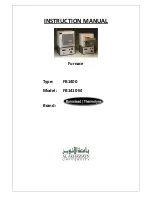
IO-213D
2/04
6
APPLIANCE. DO NOT CONNECT TO AN EXISTING VENT OR
CHIMNEY UNLESS IT CONFORMS TO ALL PROVISIONS IN
THIS INSTRUCTION BOOKLET.
THE VENT MUST TERMINATE
OUTDOORS.
VENT/COMBUSTION AIR SUPPLY PIPE LENGTHS
Elbows must be long radius types. (Quarter bends or DWV).
The maximum length of the vent pipe and the combustion
air supply pipe is 100 feet each.
Model
Vent @
Vent @ more Comb. Air @ Comb. Air @
GMNT
45 ft.
than
45 ft.
More than 45
or less
45 ft.
or less
45 ft.
040-3
2 in.
3 in.
2”
3”
060-3
2 in.
3 in.
2”
3”
080-4
3 in.
3 in.
3”
3”
100-4
3 in.
3 in.
3”
3”
120-5
3 in.
3 in.
3”
3”
Chart assumes a maximum of 4 - 90° elbows. For excess
of 4 elbows decrease length by 7.5 ft. per elbow. A
maximum of 6 elbows is acceptable. The use of two 45°
over one 90°
is preferred. Do not count the termination as
an elbow.
Minimum vent length is 6 ft. for vertical and horizontal runs.
There is no minimum combustion air supply pipe length.
These furnaces are a condensing type appliance. The
products of combustion are recirculated through a secondary
coil. During this process the flue products are brought to a
point below dew point. Thus the moisture present in the
flue products condenses leaving a liquid by-product. This
by-product must be removed from the furnace and it’s
collection system.
In addition, the vent temperatures are also considerably lower
than conventional furnaces. This allows the use of low
temperature plastic as the vent system. The recommended
plastic is schedule 40 PVC, ABS, DWV (or equivalent if
allowed by local code). See the previous chart for proper
sizing. The use of two 45° elbows is suggested over the use
of a single 90° elbow. The vent pipe must slope toward the
furnace to properly drain the condensate. The drain trap and
related parts must be installed as shown in the illustrations.
Failure to follow these instructions can cause products of
combustion including
CARBON
MONOXIDE
entering the
dwelling.
IF THIS FURNACE IS INSTALLED IN AN ATTIC OR SIMILAR
AREA WHERE CONDENSATE OVERFLOW MAY BE A PROBLEM,
AN AUXILIARY DRAIN PAN MUST BE INSTALLED UNDER THE
FURNACE WITH THE AUXILIARY DRAIN LINES ROUTED TO
THE OUTDOORS TO PREVENT WATER DAMAGE CAUSED
BY LEAKS.
THE COMBUSTION PRODUCTS AND MOISTURE IN THE
FLUE GASES WILL CONDENSE. THE CONDENSATE MAY
FREEZE ON THE EXTERIOR WALL AND SURROUNDING
SURFACES. SOME DISCOLORATION OR ETCHING IS TO BE
EXPECTED.
THE VENT AND COMBUSTION AIR SUPPLY PIPES MUST
BE INSPECTED ANNUALLY.
Visually check the vent terminal and combustion air supply
pipe screens, clean if necessary. Visually check for
blockage of the condensate disposal system. Hoses may
be disconnected to determine that proper flow is maintained.
Should an obstruction be observed, it can be dislodged by
forcing a stream of water through it using a device such as
a garden hose.
Materials and procedures must conform to:
The ASTM Standards.
Pipe and Fittings ASTM 1785, D2465 and D2266
PVC Primer and Solvent Cement ASTM D2564
Procedure for Cementing Joints ASTM D2855 (ref.) This
appliance may be vertically or horizontally vented.
HORIZONTAL THROUGH THE WALL VENTING
This appliance may be horizontally vented through an exterior
wall following the applicable instructions in the “VENTING”
section in conjunction with these additional requirements.
A wall sleeve must be used.
ALL HORIZONTAL VENT INSTALLATIONS MUST BE MADE
IN ACCORDANCE WITH THESE INSTRUCTIONS.
When selecting which exterior wall to penetrate, the following
items should be taken into consideration:
1. Layout the combustion air and vent system to avoid the
possibility of interference with beams, poles, posts,
electrical wiring, plumbing, etc.
2. When possible, the combustion air and vent termination
should not be subjected to prevailing winds.
3. The combustion air intake and vent termination must
be located at least twelve (12) inches above expected
snowfall. Consideration should be made to past unusual
snowfalls.
•
DO NOT
locate the terminal less than seven (7) feet above
public walkways. This applies to steps and stairwells.
•
DO NOT
locate the termination areas where condensate
may present a problem such as flowerbeds, patios, etc.
•
DO NOT
locate within four (4) feet of a gas meter, electric
meter, or gas regulator; (3) feet in Canada
•
DO NOT
locate the vent terminal within four (4) feet of an
adjacent building.
•
DIRECT VENT INSTALLATION - DO NOT
locate the vent
terminal within twelve (12) inches of an operable window
or door.
•
NON-DIRECT VENT INSTALLATION - DO NOT
locate the
vent terminal less than (12) inches above a door or
operable window.
•
NON-DIRECT VENT INSTALLATION - DO NOT
locate the
vent terminal less than (4) feet below or (4) feet horizontally
from any door, window or gravity air inlet into any building.
•
DO NOT
locate the vent terminal less than three (3) feet
above, or (10) feet horizontally from, a forced air inlet into
any building, other than the combustion air supply pipe.
•
DO NOT
locate the vent terminal within three (3) feet of an
inside corner of a building or structure. Minor corners
created by fireplace chimneys are excluded from this
requirement.
To protect the exterior surface from staining due to the
condensate, an aluminum plate or similar material may be
installed surrounding the termination. This plate should
extend approximately two (2) feet from the termination.





































